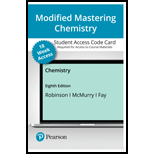
Concept explainers
(a)
Interpretation:
The example of covalent network solid related to main group chemistry needs to be determined.
Concept introduction:
All known elements are placed in the long form of periodic table according to their
(b)
Interpretation:
The example of disproportionation reaction related to main group chemistry needs to be determined.
Concept introduction:
All known elements are placed in the long form of periodic table according to their atomic number. Entire table can be divided into four blocks; s, p, d and f-block elements. The s and p-block elements are called as main-group elements. The d-block elements are also called transition elements whereas the f-block elements are inner transition elements.
(c)
Interpretation:
The example of paramagnetic oxide related to main group chemistry needs to be determined.
Concept introduction:
All known elements are placed in the long form of periodic table according to their atomic number. Entire table can be divided into four blocks; s, p, d and f-block elements. The s and p-block elements are combine called as main-group elements. The d-block elements are also called transition elements whereas the f-block elements are inner transition elements.
(d)
Interpretation:
The example of polar molecule that violets the octet rule related to main group chemistry.
Concept introduction:
All known elements are placed in the long form of periodic table according to their atomic number. Entire table can be divided into four blocks; s, p, d and f-block elements. The s and p-block elements are combine called as main-group elements. The d-block elements are also called transition elements whereas the f-block elements are inner transition elements.
(e)
Interpretation:
The example of Lewis acid related to main group chemistry needs to be determined.
Concept introduction:
All known elements are placed in the long form of periodic table according to their atomic number. Entire table can be divided into four blocks; s, p, d and f-block elements. The s and p-block elements are combine called as main-group elements. The d-block elements are also called transition elements whereas the f-block elements are inner transition elements.
(f)
Interpretation:
The example of amphoteric oxide related to main group chemistry needs to be determined.
Concept introduction:
All know elements are placed in the Long form of periodic table according to their atomic number. Entire table can be divided into four blocks; s, p, d and f-block elements. The s and p-block elements are combine called as main-group elements. The d-block elements are also called transition elements whereas the f-block elements inner transition elements.
(g)
Interpretation:
The example of semiconductor related to main group chemistry needs to be determined.
Concept introduction:
All known elements are placed in the long form of periodic table according to their atomic number. Entire table can be divided into four blocks; s, p, d and f-block elements. The s and p-block elements are combine called as main-group elements. The d-block elements are also called transition elements whereas the f-block elements are inner transition elements.
(h)
Interpretation:
The example of strong oxidizing agent related to main group chemistry needs to be determined.
Concept introduction:
All known elements are placed in the long form of periodic table according to their atomic number. Entire table can be divided into four blocks; s, p, d and f-block elements. The s and p-block elements are combine called as main-group elements. The d-block elements are also called transition elements whereas the f-block elements are inner transition elements.
(i)
Interpretation:
The example of allotropes related to main group chemistry needs to be determined.
Concept introduction:
All known elements are placed in the long form of periodic table according to their atomic number. Entire table can be divided into four blocks; s, p, d and f-block elements. The s and p-block elements are combine called as main-group elements. The d-block elements are also called transition elements whereas the f-block elements are inner transition elements.
Want to see the full answer?
Check out a sample textbook solution
Chapter 22 Solutions
CHEMISTRY-MOD.MASTERING (18W)
- K Draw the starting structure that would lead to the major product shown under the provided conditions. Drawing 1. NaNH2 2. PhCH2Br 4 57°F Sunny Q Searcharrow_forward7 Draw the starting alkyl bromide that would produce this alkyne under these conditions. F Drawing 1. NaNH2, A 2. H3O+ £ 4 Temps to rise Tomorrow Q Search H2arrow_forward7 Comment on the general features of the predicted (extremely simplified) ¹H- NMR spectrum of lycopene that is provided below. 00 6 57 PPM 3 2 1 0arrow_forward
 ChemistryChemistryISBN:9781305957404Author:Steven S. Zumdahl, Susan A. Zumdahl, Donald J. DeCostePublisher:Cengage Learning
ChemistryChemistryISBN:9781305957404Author:Steven S. Zumdahl, Susan A. Zumdahl, Donald J. DeCostePublisher:Cengage Learning ChemistryChemistryISBN:9781259911156Author:Raymond Chang Dr., Jason Overby ProfessorPublisher:McGraw-Hill Education
ChemistryChemistryISBN:9781259911156Author:Raymond Chang Dr., Jason Overby ProfessorPublisher:McGraw-Hill Education Principles of Instrumental AnalysisChemistryISBN:9781305577213Author:Douglas A. Skoog, F. James Holler, Stanley R. CrouchPublisher:Cengage Learning
Principles of Instrumental AnalysisChemistryISBN:9781305577213Author:Douglas A. Skoog, F. James Holler, Stanley R. CrouchPublisher:Cengage Learning Organic ChemistryChemistryISBN:9780078021558Author:Janice Gorzynski Smith Dr.Publisher:McGraw-Hill Education
Organic ChemistryChemistryISBN:9780078021558Author:Janice Gorzynski Smith Dr.Publisher:McGraw-Hill Education Chemistry: Principles and ReactionsChemistryISBN:9781305079373Author:William L. Masterton, Cecile N. HurleyPublisher:Cengage Learning
Chemistry: Principles and ReactionsChemistryISBN:9781305079373Author:William L. Masterton, Cecile N. HurleyPublisher:Cengage Learning Elementary Principles of Chemical Processes, Bind...ChemistryISBN:9781118431221Author:Richard M. Felder, Ronald W. Rousseau, Lisa G. BullardPublisher:WILEY
Elementary Principles of Chemical Processes, Bind...ChemistryISBN:9781118431221Author:Richard M. Felder, Ronald W. Rousseau, Lisa G. BullardPublisher:WILEY





